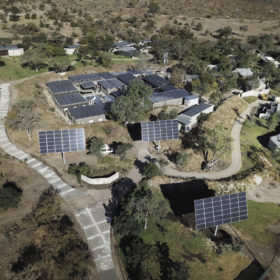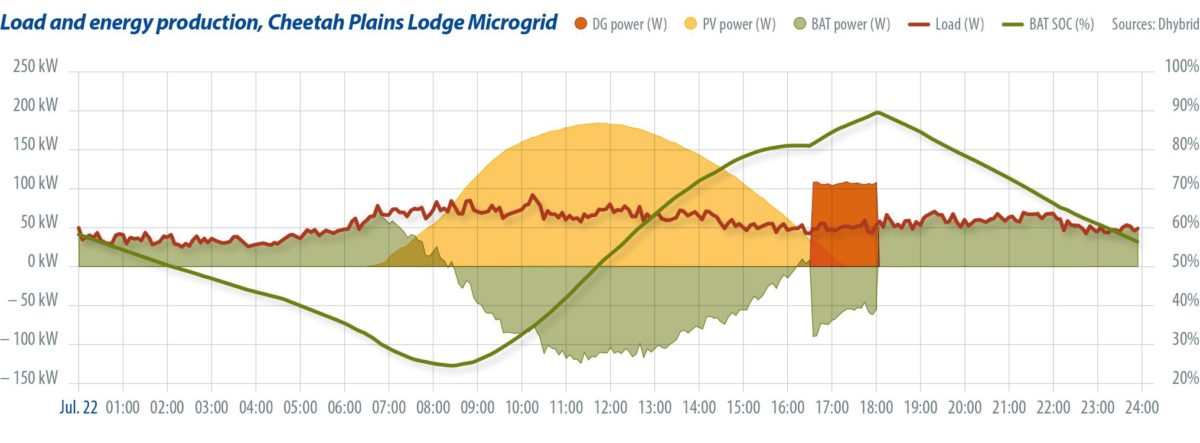
When it comes to hybrid microgrids, writes Fabian Baretzky, senior business development and sales manager for Dhybrid Power Systems, the incorporation of various sources of energy and complex requirements for long-term stability of the energy supply require expertise and an effective energy management system.
From pv magazine, November edition
When we think of a microgrid, we typically think of an installation which relies on a few sources of energy and supplies relatively few consumers with electricity. We automatically think of isolated regions – in fact, microgrids are typically equated with fully grid-independent standalone systems.
By contrast, hybrid microgrids can be connected to small public, regional or even national power grids. At the same time, they do need to be able to operate in complete self-sufficiency in order to supply consumers with electricity as needed. The power output of such hybrid microgrids ranges from a few kilowatts to several megawatts.
The customary purpose of conventional microgrids is to supply power to offgrid regions and facilities. However, the main goal of hybrid microgrids is to reduce the costs of energy provision and move more in the direction of complete independence from fossil fuels by raising the proportion of renewable energy in the energy mix. In some particular applications, there is a grid connection, but the grid is not sufficiently stable. Then the hybrid microgrid is intended to secure the supply of energy, even in the event of a blackout.
Complex requirements
Their various functions and modes of operation mean that hybrid power plants – and in particular, their energy management systems – face complex requirements. They must be able to incorporate local energy sources such as solar energy or small hydrostations, ensuring that the proportion of renewables is as great as possible, particularly with regard to the reduction of carbon emissions. The different energy generators must also be monitored and controlled accordingly in real time. This is the job of the energy management system (EMS). Acting in a manner similar to that of an orchestral conductor, the EMS monitors and optimizes all the important parameters, such as frequency and voltage, as well as active, reactive and apparent power.
As proven by the approximate 70 projects brought to fruition worldwide, electricity consumption rises as soon as a stable power supply becomes available, and this increase in consumption can range anywhere from 7 to 24%. A hybrid microgrid must also be able to keep up with and adjust to rising demand for energy.
Since power plants are designed to operate for at least 20 years, advancements in technology and components must be taken into account. Hybrid microgrids should be made ready to incorporate new developments and amended technologies – ideally regardless of the manufacturer, since market change is a given. Existing companies could disappear from the market or new suppliers could enter it and introduce innovative new technologies. Therefore, the EMS should be able to monitor and control technology of any origin.
Since these power plants are typically installed in remote areas, a supplementary web-based cloud solution, such as the one offered by Qos Energy, is practical for the energy management system. The software is intended to analyze all of the data received from components such as the PV inverter, power generator and storage system. If an operator is in charge of multiple power plants, the EMS should assist them in comparing the data coming from the various sources, in order to identify optimization potential.
A hybrid power plant must be carefully modeled in its entirety prior to installation. Taking the modeling software and also using it both for simulation and as an EMS under normal operating conditions makes the entire project more time-efficient, reduces costs and avoids technical difficulties such as power outages.
Kruger National Park
The Cheetah Plains Lodge in South Africa’s Kruger National Park showcases the benefits of an EMS optimized for hybrid power plants – in this case, Dhybrid’s Universal Power Platform (UPP). The luxury resort had been connected to the local energy company’s single-phase auxiliary feed (max. 64 kVA). In addition, demand for electricity in the region was higher than the supply, leading to continual power outages.

In the course of upgrading the building complex, a self-sufficient hybrid power plant was installed, with PV on rooftops, carports and trackers working together to provide 300 kW of generation capacity.
The installations are connected to a tailor-made lithium-ion storage system with a storage capacity of 1,027 kWh. A diesel generator with a power output of 150 kVA replaces the old generator, but is only intended as a back-up to charge the energy storage system in periods of low sunlight.
The UPP was previously used in the planning phase to simulate the microgrid and is currently used for the fully automated monitoring and control of all the components. It ensures uninterrupted energy supply and stabilizes the grid voltage and frequency. Thus, the electricity demand can almost completely be covered by renewable energy.
This technology has raised the lodge’s available peak power capacity fourfold to 250 kW. Moreover, the power plant is capable of reliably supplying electricity to large three-phase energy consumers such as cooling systems and motors without interruption. Even the charging stations for the lodge’s electric safari Jeeps are largely supplied with solar energy.
Lắp đặt điện mặt trời Khải Minh Tech
https://ift.tt/2X7bF6x
0906633505
info.khaiminhtech@gmail.com
80/39 Trần Quang Diệu, Phường 14, Quận 3
Lắp đặt điện mặt trời Khải Minh Tech
https://ift.tt/2ZH4TRU
Không có nhận xét nào:
Đăng nhận xét